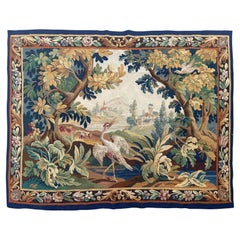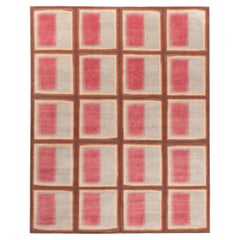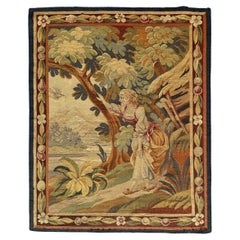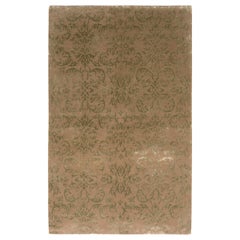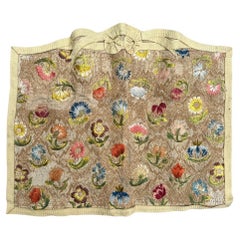Silk Western European Rugs
to
216
Width
to
Length
to
747
213
9
425
22
15
6
2
2
2
1
61
87
65
756
25
30
9
6
3
4
1
1
4
1
2
3
3
7,424
6,437
1,294
969
199
498
236
969
334
465
481
478
448
263
247
152
24
20
18
16
Material: Silk
Pretty antique french Aubusson tapestry “greenery and birds”
Located in Saint Ouen, FR
Very beautiful antique French Aubusson tapestry featuring a view of the nature in the woods, with birds, trees and a river. we can see further away, village houses. With nice natural...
Category
Mid-20th Century French Aubusson Silk Western European Rugs
Materials
Wool, Silk
$3,641 Sale Price
20% Off
cc-tapis COMPOSITION 4 Rectangular handmade rug by Kwangho Lee
By Kwangho Lee, cc-tapis
Located in Brooklyn, NY
Inspired by his copper series, Kwangho Lee and cc-tapis present The Color of Copper (TCOC), a collection of four hand-knotted rugs that reinterpret the oxidation process of this meta...
Category
21st Century and Contemporary Nepalese Silk Western European Rugs
Materials
Wool, Silk
Wonderful extremely fine antique silk french Beauvais tapestry «Flower Harvest»
Located in Saint Ouen, FR
Very beautiful late 19th century French Aubusson tapestry of Beauvais with a nice design of flower Harvest, Beautiful women are gathering flowers in the garden and the woods, chatti...
Category
Late 19th Century French Aubusson Antique Silk Western European Rugs
Materials
Silk
Pretty antique french Aubusson tapestry
Located in Saint Ouen, FR
Very beautiful antique French Aubusson tapestry featuring a view of a woman showing a bird in the nature in the woods. With nice natural colours in the hues of yellow, green, pink, o...
Category
Late 19th Century French Aubusson Antique Silk Western European Rugs
Materials
Wool, Silk
$1,724 Sale Price
20% Off
Rug & Kilim's Hand Knotted European Style Rug Beige-Brown Green Floral Pattern
By Rug & Kilim
Located in Long Island City, NY
Hand knotted in one of the most respected looms in Nepal, this 4 x 6 rug joins the European collection by Rug & Kilim, this design affectionately entitled “Arabesque” named for the i...
Category
2010s Nepalese Art Deco Silk Western European Rugs
Materials
Wool, Silk
$1,960 Sale Price
20% Off
Pretty antique Hungarian embroidery tissue
Located in Saint Ouen, FR
Beautiful antique hungarian embroidered tissue fragment , with beautiful designs of flowers and with nice natural colours, entirely hand embroide...
Category
Early 19th Century Hungarian Aubusson Antique Silk Western European Rugs
Materials
Silk
cc-tapis Orizzonti Selva Rug by Eligo Studio
By cc-tapis
Located in Brooklyn, NY
Handwoven in the cc-tapis atelier in Kathmandu, Nepal. The rug is made with a cotton weave, Himalayan wool and bamboo silk pile coming from the areas surrounding the atelier. The sal...
Category
21st Century and Contemporary Nepalese Modern Silk Western European Rugs
Materials
Cotton, Wool, Silk
cc-tapis Giudecca Rug by Zanellato/Bortotto
By cc-tapis
Located in Brooklyn, NY
Hand knotted in the cc-tapis atelier in Kathmandu, Nepal. The rug is made with a cotton weave a Himalayan wool and pure silk coming from the areas surrounding the atelier. 152.000 individual knots per square meter approximately. The sale of every rug supports cc-foreducation. Size: 5' x 7.9' ft. A+ (152.000 knots/sqm approx.)
From a photo of a flight of stairs in Venice, came the idea to reinterpret the iconic image of the steps covered in water by the lagoon. The different tones of gray of the wool create the stone steps...
Category
21st Century and Contemporary Nepalese Modern Silk Western European Rugs
Materials
Wool, Silk
$8,432 / item
Late 19th Century French Aubusson Verdure Tapestry with Louis XVI Revival Style
Located in Dallas, TX
79208 Late 19th Century Antique French Aubusson Tapestry, 06'00 x 08'10. A sanctuary of woven splendor and poetic artistry, this handwoven wool and silk French Aubusson tapestry from...
Category
Late 19th Century French Gothic Antique Silk Western European Rugs
Materials
Wool, Silk
cc-tapis Strict Rayures So Much Fun Collection by Claude Cartier Studio
By cc-tapis
Located in Brooklyn, NY
So much fun is a collection of rugs where black and white geometric elements define joyful and colorful patterns giving life to 3 different designs, customizable in multiple variations in terms of size, colors, and textures. A collection that offers different production techniques from hand knotted to hand-woven.
Claude Cartier Decoration...
Category
21st Century and Contemporary Nepalese Modern Silk Western European Rugs
Materials
Wool, Silk
cc-tapis Rug Ultimate Bliss Gold by Mae Engelgeer for Duplex, Showroom Sample
Located in Brooklyn, NY
Duplex launches “Gold is Bold" project: a unique collaboration with cc-tapis to celebrate boldness.
The iconic Biss rug collection designed by Mae Engelgeer and hand knotted in N...
Category
21st Century and Contemporary Nepalese Modern Silk Western European Rugs
Materials
Wool, Silk
BEAUMONT – Custom Handmade Rug by Rugs & Co.
Located in Herzliya, IL
BEAUMONT is an urban layer of earth reborn. Its sandy-brown tones and soft lines that outline its asymmetrical body recall cracked earth — but not broken.
The rug is handwoven from o...
Category
21st Century and Contemporary Indian Modern Silk Western European Rugs
Materials
Silk
$4,054 / item
Pretty vintage French needlepoint tapestry, « Moses saved from the Nile »
Located in Saint Ouen, FR
"Experience the timeless elegance of this exquisite French Aubusson style tapestry, capturing the essence of a biblical episode, where Moses in his cradle is pulled from the waters o...
Category
Mid-20th Century French Aubusson Silk Western European Rugs
Materials
Wool, Silk
$5,040 Sale Price
20% Off
ETERNA – Custom Handmade Rug by Rugs & Co.
Located in Herzliya, IL
ETERNA is a visual breath—an almost weightless expression of continuity. With soft, interlocking forms that echo one another in gentle waves, the rug evokes infinity through simplici...
Category
21st Century and Contemporary Indian Modern Silk Western European Rugs
Materials
Silk
$4,054 / item
MYTHOS – Custom Handmade Rug by Rugs & Co.
Located in Herzliya, IL
The MYTHOS rug moves between mythology and modern form—a single thick, flowing line, like a thread of a story that twists and turns but remains clear. Its dynamic shape winds across ...
Category
21st Century and Contemporary Indian Modern Silk Western European Rugs
Materials
Silk
$4,054 / item
Bobyrug’s Pretty Vintage French Aubusson Tapestry
Located in Saint Ouen, FR
Very beautiful mid century french Aubusson tapestry with beautiful gallant design and beautiful colors, entirely hand woven at Aubusson manu...
Category
Mid-20th Century French Aubusson Silk Western European Rugs
Materials
Wool, Silk
Early 18th century Flemish antique tapestry 10x13 Verdure Wool & Silk 297x384cm
Located in New York, NY
Early 18th Century Antique Flemish Tapestry Fine Verdure Wool & Silk
9'9" x 12'7"(10x13) 297cm x 384cm
Circa 1720
"This is a very fine Authentic Antique Flemish wool & silk Tapest...
Category
Early 18th Century Belgian Baroque Antique Silk Western European Rugs
Materials
Wool, Silk
$17,600 Sale Price
44% Off
Late 17th Century Franco-Flemish Rustic Tapestry
Located in New York, NY
A Franco-Flemish rustic tapestry, possibly Lille or Aubusson, from the late 17th century, featuring a rustic scene with a group of people singing and playing music in a verdant setti...
Category
Late 17th Century European Rustic Antique Silk Western European Rugs
Materials
Wool, Silk
$27,995 Sale Price
41% Off
Late 19th Century French Verdure Aubusson Tapestry with Louis XV Style
By Jean-Baptiste Oudry
Located in Dallas, TX
78831 Late 19th Century Antique French Aubusson Verdure Tapestry, 06'10 x 09'08. Woven in the storied ateliers of Aubusson during the late 19th century, this handwoven wool and silk ...
Category
Late 19th Century French Aubusson Antique Silk Western European Rugs
Materials
Wool, Silk
$16,799 Sale Price
20% Off
Late 16th Century Flemish Historical Tapestry, with the Roman General Scipio
Located in New York, NY
A Flemish tapestry from the late 16th century, with the renowned Roman general, Scipio at left, after having conquered Carthage in the Battle of Zama, en...
Category
16th Century European Antique Silk Western European Rugs
Materials
Wool, Silk
$25,996 Sale Price
20% Off
17th Century Antique Flemish Verdure Tapestry w/ Trees & bird
Located in New York, NY
An antique 17th century Flemish Verdure Landscape Tapestry
An antique 17th century Flemish verdure landscape tapestry, size: 7.4 H x 4.9 W. This fine handwoven European wall hanging...
Category
17th Century Belgian Antique Silk Western European Rugs
Materials
Wool, Silk
$10,396 Sale Price
20% Off
cc-tapis Disco So Much Fun Collection by Claude Cartier Studio
By cc-tapis
Located in Brooklyn, NY
So much fun is a collection of rugs where black and white geometric elements define joyful and colorful patterns giving life to 3 different designs, customizable in multiple variations in terms of size, colors, and textures. A collection that offers different production techniques from hand-knotted to hand-woven.
Claude Cartier Decoration...
Category
21st Century and Contemporary Nepalese Modern Silk Western European Rugs
Materials
Wool, Silk
Rug & Kilim's Traditional European Style Rug Green and Gold Pictorial Pattern
By Rug & Kilim
Located in Long Island City, NY
This 4 x 6 rug joins the European collection by Rug & Kilim, drawing inspiration from a western interpretation of traditional dragon and phoenix imagery alternating within the golden...
Category
2010s Nepalese Art Deco Silk Western European Rugs
Materials
Wool, Silk
$2,320 Sale Price
20% Off
cc-tapis Rug Bliss Ultimate Undyed Round Natural by Mae Engelgeer
Located in Brooklyn, NY
Born in France. Designed in Milan. Produced in Nepal.
cc-tapis is an Italian company which produces contemporary hand-knotted rugs which are created in Nepal by expert Tibetan artis...
Category
21st Century and Contemporary Nepalese Modern Silk Western European Rugs
Materials
Wool, Silk
Antique French Tapestry Verdure Birds Wool & Silk 1920 6x7
Located in New York, NY
Antique French Tapestry Verdure Birds Wool & Silk 1920 6x7
6' x 7'3" 221cm x 183cm
"A magnificent antique French tapestry depicting birds amongst a verdure setting. Beautiful colo...
Category
1920s French Baroque Vintage Silk Western European Rugs
Materials
Wool, Silk
$7,400 Sale Price
20% Off
Nice modern French Aubusson Tapestry by « Lartigaud »
Located in Saint Ouen, FR
Discover the elegance of modern French tapestry with the exquisite design by Jean Michel Lartigaud. This limited edition masterpiece, woven in vibrant shades of orange, yellow, red, ...
Category
Mid-20th Century French Modern Silk Western European Rugs
Materials
Wool, Cotton, Silk
$4,771 Sale Price
20% Off
Antique 17th Century Flemish Historical Tapestry, Featuring Dido and Aeneas
Located in New York, NY
A French Aubusson historical tapestry from the late 17th century, depicting Aeneas relating his adventures to Dido, from 'The Story of Dido and Aeneas'...
Category
17th Century Belgian Antique Silk Western European Rugs
Materials
Wool, Silk
$44,995 Sale Price
50% Off
LUNA – Custom Handmade Rug by Rugs & Co.
Located in Herzliya, IL
LUNA is a tribute to the moon—a body that illuminates without burning. Its crescent shape and harmonious composition in white, cream, gray, and light blue give the Rug a soft yet cap...
Category
21st Century and Contemporary Indian Modern Silk Western European Rugs
Materials
Silk
$4,054 / item
Pretty antique Antique French Needlepoint Panel Tapestry
Located in Saint Ouen, FR
Beautiful late 19th century needlepoint tapestry with nice design of the forest with vegetation and beautiful light colors with the hues of yellow, green, brown and white, entirely h...
Category
Late 19th Century French Aubusson Antique Silk Western European Rugs
Materials
Wool, Silk
$2,165 Sale Price
20% Off
BRONTE – Custom Handmade Rug by Rugs & Co.
Located in Herzliya, IL
BRONTE is a soft hand-drawn line on a clean background. Layers in tones of sand, brown, and white gently shift between informal form and graphic structure. A rug that recalls erosion...
Category
21st Century and Contemporary Indian Modern Silk Western European Rugs
Materials
Silk
$4,054 / item
Hand-Knotted Antique Heriz Persian Style Rug in Red Floral Pattern
Located in Long Island City, NY
Enjoying the artistic vision of one of the finest German workshops circa 1920-1930, this 8x11 ode to antique Persian Heriz rug styles is a rare piece in its lineage. A graceful piece...
Category
1920s German Heriz Serapi Vintage Silk Western European Rugs
Materials
Silk
$30,400 Sale Price
20% Off
Kandinsky first abstract watercolor (1913) reproduction carpet hanger
Located in Vienna, AT
Kandinsky first abstract watercolor (1913) reproduction carpet hanger
carpet in very good condition, pile in perfect condition and color as vibrant as when made.
subject is a reprod...
Category
1980s Vintage Silk Western European Rugs
Materials
Wool, Cotton, Silk
Late 19th Century French Aubusson Tapestry Inspired by Francois Boucher
Located in Dallas, TX
73139 Late 19th Century Antique French Aubusson Tapestry, 05'02 x 06'04. Woven in the celebrated ateliers of Aubusson during the late 19th century, this exquisite French tapestry ech...
Category
Late 19th Century French Belle Époque Antique Silk Western European Rugs
Materials
Wool, Silk
$8,848 Sale Price
26% Off
Evolution Part II Rug by Illulian Design Studio Limited Edition
By Illulian
Located in Milan, IT
These unique rug models are customizable in terms of size, colors, shape and composition (percentage of silk compared to the percentage of Himalayan wool or other materials requested...
Category
2010s Italian Silk Western European Rugs
Materials
Wool, Silk
Antique 17th Century Flemish Verdure Tapestry, with Exotic Birds in a Landscape
Located in New York, NY
An antique Flemish landscape verdure tapestry from the late 17th century, envisioning two exotic birds in an idyllic woodland setting, with a stream separating the foliage in foregro...
Category
Late 17th Century Belgian Antique Silk Western European Rugs
Materials
Wool, Silk
Late 19th Century Romantic French Aubusson Tapestry Inspired by Paul Cézanne
Located in Dallas, TX
78623 Late 19th Century Antique French Aubusson Tapestry, 07'10 x 07'10. An extraordinary opportunity of cultivated distinction, this one-of-a-kind, handwoven wool and silk French Au...
Category
Late 19th Century French Belle Époque Antique Silk Western European Rugs
Materials
Wool, Silk
$10,080 Sale Price
27% Off
cc-tapis Hello Sonia! Rhapsody 3 in Light Red by Studiopepe
By cc-tapis, Studiopepe
Located in Brooklyn, NY
Geometric elements, evoking the avant-garde textiles of the early 1900s, a theme which runs through the whole Hello Sonia Family, are now arranged harmonio...
Category
21st Century and Contemporary Nepalese Modern Silk Western European Rugs
Materials
Wool, Silk
Tabriz Destroyer Rug by cc-tapis
By cc-tapis
Located in Brooklyn, NY
Hand knotted in the cc-tapis atelier in Kathmandu, Nepal. The rug is made with a cotton weave, a Himalayan wool and pure silk, coming from the areas surrounding the atelier. 152.000 individual knots per square meter approximately. The sale of every rug supports cc-foreducation. Size: 7.2' x 7.5' ft. A+ (152.000 knots/sqm approximate).
An inter-galactic, shape-shifting army of contemporary hand knotted rugs taking inspiration from traditional rug motifs and icons. The Rug Invaders...
Category
21st Century and Contemporary Nepalese Modern Silk Western European Rugs
Materials
Cotton, Wool, Silk
21st Century Art Deco Elie Saab Maison Wool and Bamboo Silk Monogram Rug, Italy
Located in Mariano Comense, CO
21st century Art Deco Elie Saab Maison wool and bamboo silk monogram rug, Italy
The Elie Saab crest, a distinctive element of the Elie Saab universe, becomes the focal point of this impressive and scenographic PALMIER Rug, created in partnership with Sahrai. Inspired by an imperial and royal pattern synonyms with luxury and innate elegance, the crest represents the initials of Elie Saab creating a seal that portrays the brand’s identity and is embellished on gowns and accessories reflecting sophistication and distinction. Combining the distinctive Elie Saab crest with the shapes and colours inspired by the natural elements of the Middle Eastern landscapes...
Category
2010s Italian Art Deco Silk Western European Rugs
Materials
Wool, Silk
Very Beautiful Antique Pair of silk velvet Curtains
Located in Saint Ouen, FR
Wonderful pair of curtains from late 19th century, with a nice silk velvet tissue and a needlepoint band applied on it.
Size of each piece is 105x295 cm
✨✨✨
"Experience the epitome o...
Category
Late 19th Century French Napoleon III Antique Silk Western European Rugs
Materials
Silk
17th Century Needlework Armorial Table Carpet
Located in Canterbury, GB
A RARE HERALDIC TABLE CARPET 17TH CENTURY
Circa 1650 Probably Netherlands
Entirely hand worked in gross and petit point silk and wool needlework. Central oval petit point cartou...
Category
17th Century Dutch Baroque Antique Silk Western European Rugs
Materials
Wool, Silk
cc-tapis Metroquadro Dusk Rug
By cc-tapis
Located in Brooklyn, NY
Handwoven in the cc-tapis atelier in Kathmandu, Nepal. The rug is made with a cotton weave, Himalayan wool and bamboo silk pile coming from the areas surrounding the atelier. The sal...
Category
21st Century and Contemporary Nepalese Modern Silk Western European Rugs
Materials
Wool, Cotton, Silk
Large Runner Rug, Cream Wool Green Silk, Kelly Wearstler The Rug Company
Located in Glasgow, GB
A custom-made Kelly Wearstler rug from 2016, this elongated hand-knotted runner was privately commissioned through The Rug Company and presents a pared-back take on the designer’s we...
Category
2010s Indian Organic Modern Silk Western European Rugs
Materials
Wool, Silk
cc-tapis Pure Campo Rug by Leonardo Talarico
Located in Brooklyn, NY
Campo Pure rug, designed by Leonardo Talarico, is part of "Pure", a Mood, a subtle aesthetic, and a selection of cc-tapis classic rugs interpreted in a soft and elegant palette. The ...
Category
21st Century and Contemporary Nepalese Modern Silk Western European Rugs
Materials
Silk, Linen
$4,484 / item
cc-tapis COMPOSITION 3 handmade rug by Kwangho Lee
By cc-tapis, Kwangho Lee
Located in Brooklyn, NY
Inspired by his copper series, Kwangho Lee and cc-tapis present The Color of Copper (TCOC), a collection of four hand-knotted rugs that reinterpret the oxidation process of this meta...
Category
21st Century and Contemporary Nepalese Silk Western European Rugs
Materials
Wool, Silk
$12,563 / item
Louis XIV Style Antique French Aubusson Verdure Tapestry, Venus and Adonis
Located in Dallas, TX
Mid-18th Century Antique French Aubusson Verdure Tapestry, Venus and Adonis Wall Hanging 13'09 x 09'05. A rare jewel from the heart of 18th-century France, this handwoven wool and silk Aubusson verdure tapestry offers more than aesthetic beauty—it is a portal to a bygone era of aristocratic grandeur and mythological reverence. Woven by master artisans whose skill and devotion were reserved for the noble elite, this extraordinary tapestry captures the romantic tragedy of Venus and Adonis in a style that pays homage to the great Italian Baroque painters—Francesco Albani...
Category
Mid-18th Century French Aubusson Antique Silk Western European Rugs
Materials
Wool, Silk
$55,999 Sale Price
20% Off
Antique french Needlepoint Panel or border Tapestry
Located in Saint Ouen, FR
Beautiful late 19th century needlepoint tapestry in the form of a stripe or border fragment, with nice floral design and beautiful colours, entirely hand embroidered with needlepoint...
Category
Late 19th Century French Aubusson Antique Silk Western European Rugs
Materials
Wool, Silk
$2,165 Sale Price
20% Off
Antique Tapestry One of pair 3'7'' x 5'2''
Located in New York, NY
Antique Tapestry One of pair 3'7'' x 5'2''.
Category
Early 19th Century French Antique Silk Western European Rugs
Materials
Wool, Silk
Antique Greek Embroidery from Eastern Europe in the Style of Ottoman Ones
Located in Istanbul, TR
The embroidery is in rather good condition and seems to been on a frame before my possession of the piece.
Category
Early 20th Century Macedonian Suzani Silk Western European Rugs
Materials
Silk
1900 Antique French Tapestry Wool & Silk Game 7x7 Square 196cm x 201cm
Located in New York, NY
1900 Antique French Tapestry Wool & Silk Game 7x7 Square 6'5" x 6'7" 196cm x 201cm
"This is an outstanding antique French Aubusson tapestry in a fantastic large square size- This wo...
Category
Early 1900s French Baroque Antique Silk Western European Rugs
Materials
Wool, Silk
$9,991 Sale Price
20% Off
17th century Antique Aubusson/Gobelin tapestry, France Architectural land, silk
Located in Berlin, DE
17th century Antique Aubusson/Gobelin tapestry, France Architectural landscape, silk
Antique Museal Aubosson tapestry made of silk and partly wool. Very fine and antique design. Dep...
Category
17th Century French Baroque Antique Silk Western European Rugs
Materials
Wool, Silk
cc-tapis Rug Ultimate Bliss Gold Round by Mae Engelgeer for Duplex
Located in Brooklyn, NY
Duplex launches “Gold is Bold" project: a unique collaboration with cc-tapis to celebrate boldness.
The iconic Biss rug collection designed by Mae Engelgeer and hand knotted in N...
Category
21st Century and Contemporary Nepalese Modern Silk Western European Rugs
Materials
Wool, Silk
Bobyrug’s Pretty antique French Aubusson Tapestry
Located in Saint Ouen, FR
Very pretty mid century french Aubusson tapestry with beautiful design of a flowerpot with nice colours in a black background.
Entirely handwoven with wool and silk on cotton foundat...
Category
Mid-20th Century French Aubusson Silk Western European Rugs
Materials
Wool, Silk
cc-tapis Hello Sonia! Rhapsody 3 in Dark Blue by Studiopepe
By cc-tapis, Studiopepe
Located in Brooklyn, NY
Geometric elements, evoking the avant-garde textiles of the early 1900s, a theme which runs through the whole Hello Sonia Family, are now arranged harmoniously in a musical score...
Category
21st Century and Contemporary Nepalese Modern Silk Western European Rugs
Materials
Wool, Silk
Pretty antique 17th century French Aubusson Tapestry fragment
Located in Saint Ouen, FR
"Exquisite fragment of a border of a French Aubusson tapestry from the middle of the 17th century, featuring a beautiful design of flowers and nice natural colours, entirely hand wov...
Category
Mid-17th Century French Aubusson Antique Silk Western European Rugs
Materials
Wool, Silk
Antique Greek Embroişdery from Naxos, Early 19th Century
Located in Istanbul, TR
The size denotes that the piece was embroidered as a pillow top.
Category
Early 19th Century Greek Suzani Antique Silk Western European Rugs
Materials
Silk
cc-tapis Pure Campo Rug by Leonardo Talarico
Located in Brooklyn, NY
Campo Pure rug, designed by Leonardo Talarico, is part of "Pure", a Mood, a subtle aesthetic, and a selection of cc-tapis classic rugs interpreted in a soft and elegant palette. The ...
Category
21st Century and Contemporary Nepalese Modern Silk Western European Rugs
Materials
Silk, Linen
$4,771 / item
cc-tapis Guadalupe Collection Piñata Rug by Bethan Laura Wood
Located in Brooklyn, NY
Guadalupe Collection is inspired by The New Basilica of Our Lady of Guadalupe in Mexico City, one of the most visited religious sites in the world designed by Pedro Ramírez Vázquez together with four other architects in 1974; a symbol of Mexican culture...
Category
21st Century and Contemporary Nepalese Modern Silk Western European Rugs
Materials
Wool, Silk
Nice modern French Aubusson Tapestry by « Lartigaud »
Located in Saint Ouen, FR
Discover the elegance of modern French tapestry with the exquisite "Floride" (Florida) design by Jean Michel Lartigaud. This limited edition masterpiece, woven in vibrant shades of o...
Category
Mid-20th Century French Modern Silk Western European Rugs
Materials
Wool, Cotton, Silk
$3,378 Sale Price
20% Off
Circular Metamorphosis Wool and Art Silk Rug FB Collection
Located in Milan, IT
A wavy and earth-toned pattern in opposite sections of this wool and artificial silk rug add a touch of color and elegance. A designer logo and cotton backing complete this beige rug...
Category
2010s Italian Silk Western European Rugs
Materials
Wool, Silk
Recently Viewed
View AllMore Ways To Browse
Castelli Platone
Cathedral Clock
Cenedese Aquarium
Ceramic Dogs Italy
Chelsea Pottery
Chi Rho
Chinese Han Dynasty Bronze Vase
Chinese Screen Inlay
Chinese Stacking Box
Chinese Wash Stand
Chinoiserie Dressing Table
Chippendale Highboy
Chippendale Mahogany Block Front
Christopher Walling Gold
Cigarette Compact
Civil War Chest
Cobalt Blue Decanter
Coco House
